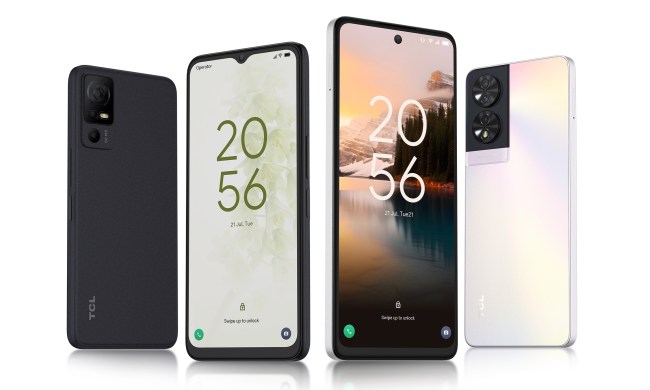Mobile phones are now old enough for people to be nostalgic about the devices they owned years ago. Perhaps it was their first phone, or one that had a particular feature which made it stand above the rest, or it was a trendsetter that made you feel great when you took it out of your pocket.
There are a few companies tapping into that nostalgia today, most notably HMD Global and Nokia, along with BlackBerry to a certain extent — but the pool of devices that are ripe for a reboot is greater than the Nokia 3310, Nokia 8810, and a keyboard-equipped BlackBerry.
Here are some of the old phones we’d like to see come back with a modern spin.
Nokia N-Gage
The original N-Gage launched in 2003, and was a response to handheld gaming machines from Nintendo, Sega, and others. It’s mobile gaming intentions are clear from the shape, which lends itself to two-handed use, just like a console controller. The only thing was, at the time, the games were almost universally terrible. A gaming phone without decent games was destined for failure, and so it was.
Today, that’s not the case, and mobile gaming is a multibillion-dollar global industry. The majority of games are playable on all phones, but we’re stuck with third-party gaming controllers if we want to recreate the exact same shape the N-Gage offered 15 years ago. Nokia is enjoying a resurgence at the moment, and its retro phones are huge hits among phone fans. Why not give the N-Gage another shot?
Motorola Razr V3i
Big surprise, right? The Motorola Razr is accepted as a design classic, and a phone many of us have owned at some point. The V3i was one of the final Razr models introduced before Motorola closed the range and updated it to the less-successful Razr2. It was the epitome of the model line, and the almost perfect implementation of the flip phone style.
Motorola has reintroduced the full Motorola name on its latest Moto G6 phones, indicating it’s keen to trade on its massive legacy. How about a new Razr when foldable screens are possible? We’re not far away, and have seen the first versions already — the ZTE Axon M for example. Calls for a rebooted Razr have come for years, but now the technology is nearing the point where a modern interpretation that retains the original’s charm is possible.
Motorola Aura R1
Forget any reboot; we wish an original R1 was sat on our shelf inside a glass case right now. The Aura R1 has a circular screen, like a smartwatch, covered in sapphire crystal, and the body is made from stainless steel. It’s related to a flip phone, but instead of flipping open the top of the shell swivels to reveal the keypad, an action made possible with an incredibly intricate gear system designed and made in Switzerland. The gears were visible through a panel on the back of the phone.
Smartwatches imitate mechanical watches today, but this work of art was a phone imitating a mechanical watch. Don’t change much, Motorola — just bring back the Aura in some form. A pocket smartwatch, perhaps?
LG Chocolate
LG really cracked design with the Chocolate range. While the U.S. only saw a handful of Chocolate phones — which weren’t actually made of chocolate, sorry — in Europe and Asia the range was more expansive, and included the touch sensitive red buttons on the case, which became a Chocolate phone trademark. Most were slider phones, but toward the end of the line in 2009, the BL40 wide-screen phone with a full touchscreen came with a very different look. It even had a 21:9 aspect ratio, reminiscent of the 18:9 and 19:9 ratio trend we see today. We’d love to see LG tap into the design talent that produced the Chocolate range again.
Nokia 7280

One of the most unusual mainstream phones ever made, the Nokia 7280 was often referred to as the Lipstick Phone, and to understand why, you just have to look at it. It didn’t hide its fashionable status either, with the tiny screen becoming a mirror when it wasn’t showing anything.
Why would we want to see another? Why not? It’s totally unlike anything else out there, just as it was back in 2004 when the 7280 launched. Put a capable camera on the back, and the ergonomics, design, and overall simplicity will do the rest.
Palm Pre
Why would we want the Palm Pre to come back? BlackBerry’s KeyOne has proven there is demand for a phone with a physical keyboard, and it’s catering to those interested in such a device almost on its own. Those who remember the Palm Pre will no doubt dream of a webOS (the phone’s operating system) mobile revival, but the software has gone on to thrive on televisions. Instead, an Android-based Pre-style phone, with cute pebble-like design, wireless charging, and a slider keyboard would no doubt attract plenty of attention today.
The return of collaborations
Not a phone specifically, but a way of making phones. A decade ago, fashion brands were paying attention to phones and several unusual and interesting partnerships sprung up in the technology industry because of it. Prada joined with LG, Giorgio Armani teamed up with Samsung, and D&G sided with Motorola. Today, fashion brands edge toward smartwatches, which are a more natural extension than phones for these companies, but we’d still like to see more top designers get involved with shaping phones today. We love limited editions, and while OnePlus and Huawei among others have interesting collaborations today, we’d like to see more. Just as long as it’s not only a collection of wallpapers and a special box. Put some effort in, please.
These are our favorites that we’d like to see given a new lease of life in the near future. Do you have any old phone favs that would benefit from a modern spin?



